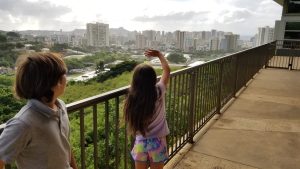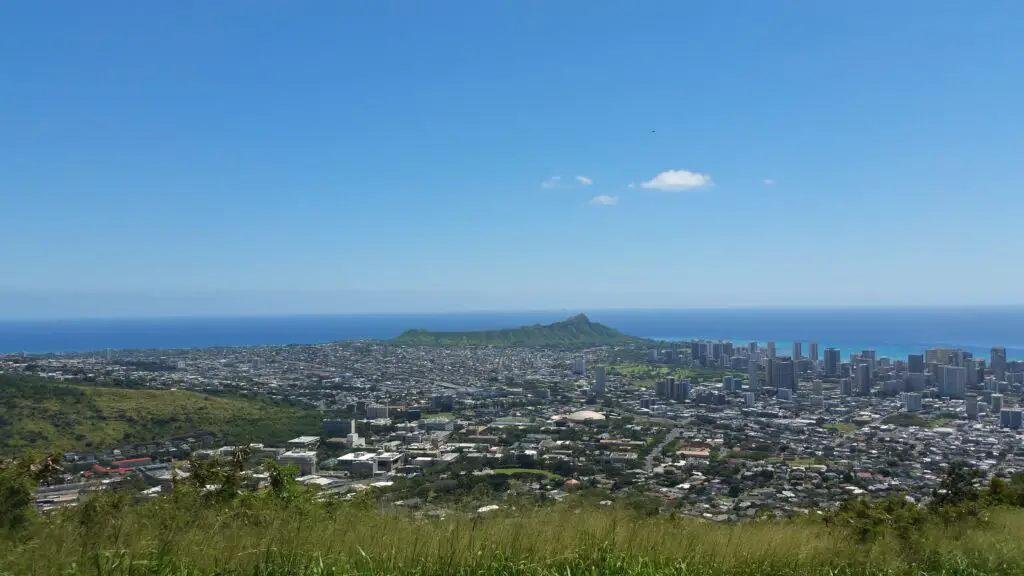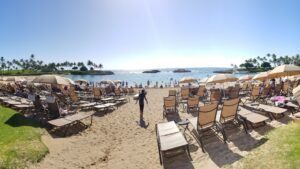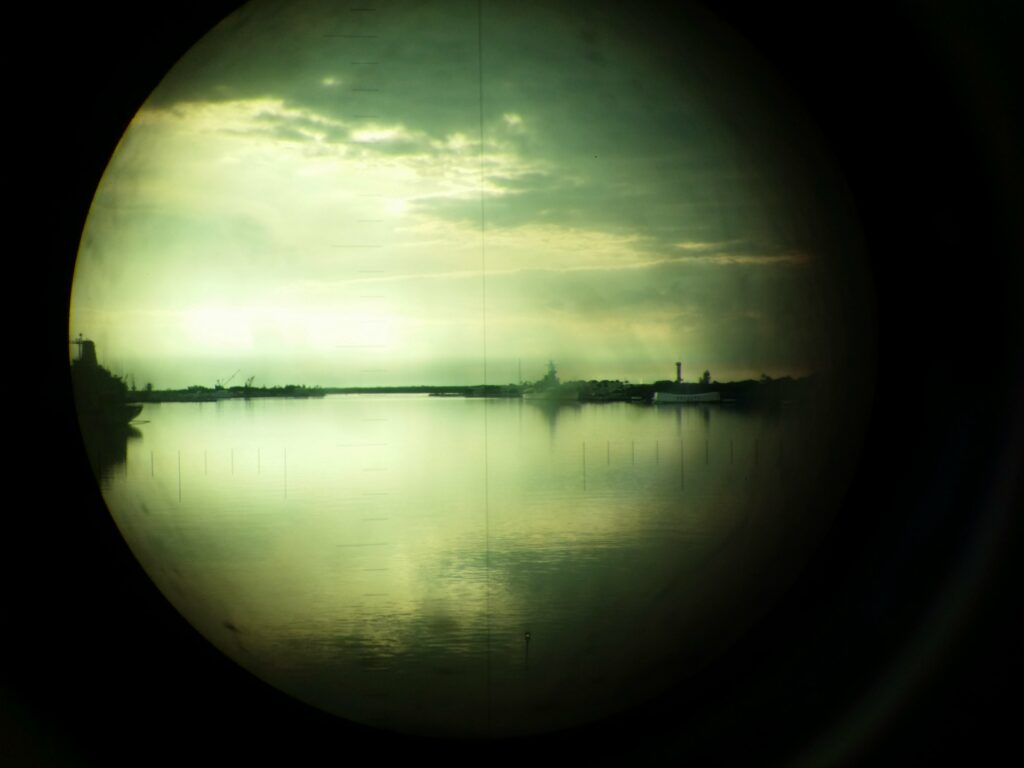A Little Bit About Oahu…
Oahu is the second oldest and the third-largest island of the Hawaiian Island chain. Home to Honolulu, Waikiki, Pearl Harbor, and recent TV series like Hawaii Five-O, Magnum P.I., and currently, NCIS: Hawai’i. Oahu is the most urban of all the Hawaiian Islands and home to about 68% of Hawaii’s population. Oahu may feel less relaxed and more fast-paced than the other islands (well as fast-paced as you can get on an island in the middle of the Pacific Ocean), with luxury high-rise condominium and glass offices towers, busy mega shopping centers, crowded beaches, and…traffic (more about that later). However, Oahu is also home to many historic sites, hiking trails, and out-in-the-country locales too. To summarize, if you’re looking for an island with the conveniences of 24-hour grocery stores, late-night eateries, and vibrant urban life while still experiencing the tropical sunsets, lush hiking trails, and beautiful beaches, Oahu might be the place for you.

Downtown Honolulu and Diamond Head from Punchbowl.
Growing up on Oahu, then living on the mainland for over 15 years, followed by moving back to Oahu with my family, made me realize that although a lot of things have changed (um, wrinkles, anyone?), I really missed all the sights and sounds that made up Oahu. As a result, once we moved back, we spent the first few months playing tourist. Later, we somehow ended up playing tour guide to the many friends and family members who paid us a visit once we were settled on Oahu. (WAIT…Why did no one visit us in Minnesota?!!! We lived there for 15 years!)
Fun Fact: In addition to the current NCIS: Hawai’i series (2021-present), Oahu was the film location for TV shows and films including but not limited to: Magnum P.I. (1980–1988) and (2018–2024), Hawaii Five-0 (1968–1980) and (2010–2020), Jurassic Park (1993), Baywatch Hawaii (1999–2001), Pearl Harbor (2001), 50 First Dates (2004), Forgetting Sarah Marshall (2008), Lost (2004–2010), Jumanji: Welcome to the Jungle (2017), and many others.
Airport
Oahu has one main airport located right outside of downtown Honolulu – the Daniel K. Inouye International Airport. Oahu does have a few other airfields but they are either for small aircraft use or located on a military base.
Regions
For geographical and weather purposes, Oahu can be divided into five regions: Honolulu and the surrounding area, Windward (East) Side, Leeward (West) Side, North Shore, and Central Oahu.
First off, Honolulu is both a city and the county for all of Oahu – i.e. you might see signs for the “City and County of Honolulu” around the island. This is most bothersome when doing a map or GPS search for places on Oahu. For example, if you search for “quick dining/places to visit/etc. Honolulu,” search results may list restaurants, tourist spots, and other locations under “Honolulu,” even though they may actually be in another town/city 30-45 minutes away. While I’ve recently noticed some searches are getting better than this, make sure to double-check for the location’s proximity before you find yourself on the other side of Oahu or something.
Honolulu and the surrounding area: The city of Honolulu is on the southeastern part of Oahu. It encompasses several famous neighborhoods including Waikiki, Diamond Head, and Downtown Honolulu. Waikiki is famous as a favorite and primary tourist hub, housing most of the hotels, convenient shopping and dining areas, and the world-famous Waikiki Beach. Diamond Head is the name of Oahu’s famous volcanic crater – and a well-known hiking spot – as well as home to a variety of boutique hotels, residences, and shops. Downtown Honolulu houses the Hawaii State Capitol building and the famous Iolani Palace but it’s also mostly a working district – expect it to be busy Monday through Friday during the work day but relatively quiet during the evenings and weekends. The primary exception is Honolulu’s Chinatown, an area of downtown Honolulu has a lot of restaurants, small shops, and even an open market area.

View of Diamond Head and Honolulu.
Windward Side: The Windward side or eastern side of Oahu is usually known as the rainier, lush, and green side of the island – while there are other parts of Oahu that are lush and green, this area is green-green, like Jurassic Park green. Kailua and Kaneohe are the two main towns on the Windward side. Kailua is probably most famous for Kailua Beach Park and Lanikai Beach, the Lanikai Pillbox hike (bring sunscreen!), as well as cute boutique shops and eateries. In local opinion, Kailua is also a little less rainy than Kaneohe. Kaneohe is known for the Marine Corps Base Hawaii in Kaneohe Bay, the Kaneohe Bay Sandbar, and the Valley of the Temples Memorial Park.
Leeward Side: The Leeward side or the western side of the island is typically sunnier and drier than the Windward side. In the last twenty years or so, the Leeward side has seen an explosion of residential and commercial development, with an emphasis on building the city of Kapolei as another strong urban center, second to Honolulu. Currently, the Leeward side is the primary focus for the development of the Light Rail, a mass transit system being built to connect Kapolei to Honolulu. In addition to Kapolei, the Leeward side also includes the Ka Makana Ali’i shopping center, the resort area of Ko’Olina – Mariott’s Ko’Olina Beach Club, Disney’s Aulani Resort and Spa, and the Four Seasons Resort Oahu at Ko’Olina – and the residential areas of Makaha, Ewa Beach, Nanakuli, and Waianae.

Beach in front of Aulani Resort in Ko’Olina.
North Shore: The North Shore of Oahu is probably the most rural and agricultural region of Oahu. It is home to a line of beaches that host internationally recognized surfing competitions including Vans Triple Crown of Surfing, Waimea Bay, the Banzai Pipeline, and Sunset Beach. These beaches (and the area in general) become extremely congested during the winter months when both locals and tourists flock to the North Shore to watch pro surfers ride 20+ foot waves. BE WARNED: During the winter months, these beaches are often too rough and even deadly for the everyday beach-goer. Beaches will have warning signs posted regarding dangerous surf.
In addition to the surfing competitions, the primary tourist attractions on the North Shore are Turtle Bay Resort, the Polynesian Cultural Center, and the historic town of Haleiwa. For visitors looking for a more relaxed, minimal approach to a Hawaii vacation, the North Shore has become almost like an anti-Waikiki with beach-front vacation homes for rent near small communities of local farmers, (potentially) less crowded beaches, small shops, local grocery stores, and various type of food trucks and local eateries.
Central Oahu: The central region of Oahu is mostly suburban residential communities for local residents on Oahu. Most people just pass through Central Oahu as they head toward the North Shore or the Leeward side. Central Oahu is home to the Dole Pineapple Plantation, Waikele Outlet Mall, and the Hawaii Plantation Village. Closer to Honolulu, is the historic Pearl Harbor and the USS Arizona Memorial.

Pearl Harbor Memorial.
Transportation
There are a variety of options for transportation on Oahu – car rentals, The Bus, taxis/Ubers/Lyfts, trolleys, rental bikes and scooters, airport shuttles, or tour-guided excursions – it just depends on what you’re planning to do! With Oahu’s more urban, densely populated environment it’s easy to mix and match options as needed.
Please note: It is highly recommended to plan your car rental in advance of your vacation. Between vacation travelers, national and international conventions, and even locals traveling from the neighbor islands, rental cars and other transportation services are often completely booked out if you wait until the last minute.
Car Rental: This option offers the most flexibility if you want to explore Oahu on your own. We often rent a car because we’re traveling with our kids and my parents or grandparents so it gives us more control over our schedule. However, you may want to keep these things in mind:
- Many of the hotels charge fees for parking that may not be included in the hotel fees.
- Oahu has terrible traffic and you may not want to spend several hours a day driving through it (although sometimes the scenery can be pretty.)
- If you’re staying in Waikiki or an all-inclusive resort area, you may not need a rental car. If you’re in Waikiki or near the Ko’Olina resort area on the Leeward side AND plan to just stay in the area, you may not need a rental car. Or, at least you may not need on for your entire trip. With nearby beaches, eateries, shops, and shuttles or taxis that run between the hotel and airport, why spend the money on car and parking fees?
TheBus: The Oahu public transportation system, TheBus, consists of 103 routes and 4200 bus stops. Adult one-way fare is $3.00 per ride and there is a 7-day pass for $30.00. You can also purchase Holo Cards for $2.00 which offers the ability to preload amounts and add funds as well. For more information about transit times and purchasing monthly passes please visit: TheBus or Holo Cards for more information.
Please note: I think TheBus is very convenient within Honolulu and the surrounding areas, however, if you want to go to the North Shore or more rural parts of the island, make sure you plan out your trip because TheBus doesn’t pass through as often. Just remember that traffic can always impact bus arrival times (sometimes by a lot!). Have a backup option so you’re not left stranded!

TheBus on Oahu.
Airport Shuttles: Many hotels have shuttles running regularly between the airport and hotels. Please contact your hotel for more information about their airport shuttle service. There are also shuttle services you can schedule in advance – they are not connected to a specific hotel but will pick up passengers from different hotels in the same area.
Waikiki Trolleys: Wakiki Trolleys is a nice alternative to the bus and offers a nice range of options if you’re looking to explore any where from downtown Honolulu to Sea Life Park. There are four routes with different stops allowing you to hop on and off throughout the day – it’s best to check their current schedule for the most up-to-date route information. You’ll need to buy tickets in advance as the drivers do not sell tickets.
Taxis/Lyft/Uber: Taxi services on Oahu are usually booked in advanced or you’ll need to go to a Taxi stand at a shopping center or business area to catch a taxi (vs. waving one down). They can be pricey, but within Honolulu and the surrounding areas, they are readily available. Lyft and Uber services are also easily available however, if you’re thinking of taking a taxi/Uber/Lyft from Waikiki to outside Honolulu, you might want to book the return ride in advance or at least check availability; often, while you might easily get a driver within Waikiki, it may be more difficult to catch a ride back from an out-of-Honolulu area.
Bike-Sharing, Electric Scooters, and Moped Rentals: This sort of squishes three different kinds of rentals under one umbrella but basically these are all options available for short-term rental and all available in the Waikiki and Honolulu area. Moped rental has been around for a long time with a lot of options for short-term rental all over the island. Biki has the bike kiosks all around Honolulu and the surrounding area; both bike and electric foot scooter rentals are primarily available using an app. Electric scooters have recently been given their own specific regulations on Oahu (Haw. Rev. Stat. § 291C-139), so please check with your rental provider. For all scooters and bike rentals, please check with the rental company for all the current laws and requirements.
Weather
Weather Across the Islands
There are basically two main seasons throughout most of the Hawaiian Islands: a warm, drier “summer” season – from April to November – and a “winter” season – from mid-November to March – which has slightly cooler temperatures and wetter weather. *This is approximate, as I’ve had hot Decembers and chilly Septembers but, Hawaii weather is pretty nice year round, so I wouldn’t be too worried.
There is no “monsoon” season like in many tropical climates even though it tends to rain a little more in the winter, however, there is a Hurricane Season which is between June through November, with August and September being the most active months.
A bit more on hurricane season: Hurricane season lasts from June through November. We actually do not get hit with a hurricane very often, even though some years, several come close to the Hawaiian Islands. In fact, since the 1950s, only five hurricanes have landed on the Hawaiian Islands: Hurricane Nina in 1957, Hurricane Dot in 1959, Hurricane Iwa in 1982, and Hurricane Iniki in 1992.
Often before hurricanes reach the Hawaiian Islands they get downgraded to tropical storms or depressions. Keep in mind, these storms can still cause a lot of rain, flooding, or damage to land and property even though they are no longer labeled as “hurricanes.”
If you are traveling during hurricane season, I would recommend, keeping an eye on the weather near your travel dates. Most likely, hurricanes downgrade or veer away from the Hawaiian Islands before they cause harm, but use your personal discretion to decide if it makes sense to cancel or alter your travel plans since the weather may still impact flights and activities during your vacation.
Oahu Weather
For Oahu, almost anytime is a good time to visit. This is not only because Waikiki is magical and it hardly rains there – I’m not kidding, I have stories! – but also, because even if it’s raining on one part of the island, it’s usually dry and sunny somewhere else. That being said, there are definitely cheaper times to visit, and that might also be helpful when planning a visit to any of the Hawaiian Islands. Typically, the cheaper accommodations and flights are during off-seasons, so after spring break but before school gets out (April to May) and after school starts but before the holiday season (September to October). As you can imagine, when I was going to college in the mainland, since it was for my summer and winter breaks, I always ended up needing tickets during peak seasons (i.e. expensive times!), at least I earned lots of mileage points!
Oahu Average Temperature Ranges in Fahrenheit
| JAN | FEB | MAR | APR | MAY | JUN | JUL | AUG | SEP | OCT | NOV | DEC | |
| TEMP | 66-80 | 66-80 | 68-81 | 69-83 | 71-85 | 73-87 | 74-88 | 75-89 | 74-89 | 73-87 | 71-84 | 68-81 |
Other Facts about Oahu
Oahu volcanoes: Oahu has two mountain ranges – Koolaus in the east and Waianae in the west. Although these were once active volcanoes, they have been inactive for over 100,000 years!
Tourism: On average, there are over 27,000 visitors flying into Honolulu’s Daniel K. Inouye International Airport daily.
Waikiki: Waikiki, the biggest tourist hub of the Hawaiian Islands with over 100 hotels and 8 beaches, draws over half the tourists visiting the entire Hawaiian Island chain. Interestingly, before Waikiki was a world-famous destination, it was actually swampy wetlands. This changed when the Ala Wai Canal was built and completed in the 1920s; the canal redirected the waters flowing from inland streams to the ocean and drained the area which is now Waikiki.
General Things About the Hawaiian Islands
Hawaii is the 50th state in the United States, our currency is the US dollar, and English is the most commonly spoken language in the Hawaiian Islands. We follow Hawaii Standard Time (GMT -10 hours) and Hawaii does not observe Daylight Savings Time. As of the 2020 census, our local population is very ethnically diverse with 22.9% White, 37.2% Asian, 10.8% Native Hawaiian and/or Pacific Islander, and 1.6% Black, with 25.3% of the population classifying themselves as multi-racial.
Fun Fact: Hawaii is the only state with two official languages: English and Hawaiian. While the Hawaiian language is not as commonly spoken as English, be ready to see a large number of local street names, towns, restaurants, historic sites, and more with Hawaiian names.
Travel: When visiting Hawaii from another state or country, the flight attendants will announce that you must consume all foods before landing and you must fill out a declaration form from the U.S. Department of Agriculture. This is required for each person arriving in Hawaii to prevent uninspected plants and animals from entering the Hawaiian Islands. There are also restrictions for carry-on luggage regarding certain fruits and vegetables, plants, and flowers between islands. Please check before boarding, even if you are just interisland-hopping.
Please note: The primary reason for the form and these agricultural restrictions is to protect the local ecosystems which are not always built to protect themselves from invasive pests, plants, and animals. When an invasive plant, insect, or animal is placed in the island’s local ecosystem, at a minimum, the invasive pests are annoying and costly to remove, but in more severe cases, they can completely decimate native plants and animals. To date, hundreds of plant and animal species have gone extinct with hundreds more on Endangered Species lists. As part of a community that enjoys the Hawaiian Islands, we’d like to preserve the remaining native species to the best of our abilities. Thank you!
